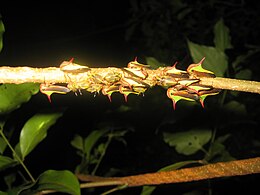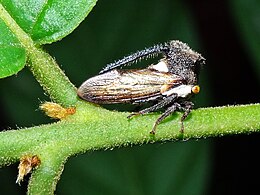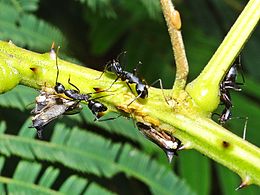Treehopper
| Treehopper | |
|---|---|

| |
| Ceresa taurina | |
| Scientific classification | |
| Domain: | Eukaryota |
| Kingdom: | Animalia |
| Phylum: | Arthropoda |
| Class: | Insecta |
| Order: | Hemiptera |
| Suborder: | Auchenorrhyncha |
| Infraorder: | Cicadomorpha |
| Superfamily: | Membracoidea |
| Family: | Membracidae Rafinesque,1815 |
| Subfamilies | |
|
Centronodinae(disputed) | |
| Synonyms | |
|
Nicomiidae | |
Treehoppers(more preciselytypical treehoppersto distinguish them from theAetalionidae) andthorn bugsare members of thefamilyMembracidae,a group ofinsectsrelated to thecicadasand theleafhoppers.About 3,200speciesof treehoppers in over 400generaare known.[1]They are found on all continents except Antarctica; only five species are known fromEurope.[citation needed]Individual treehoppers usually live for only a few months.
Morphology
[edit]Treehoppers, due to their unusual appearance, have long interestednaturalists.They are best known for their enlarged and ornatepronotum,expanded into often fantastic shapes that enhance theircamouflageormimicry,often resemblingplant thorns(thus the commonly used name of "thorn bugs" for a number of treehopper species). Treehoppers have specialized muscles in the hind femora that unfurl to generate sufficient force to jump.[2]
It had been suggested that the pronotal "helmet" could beserial homologuesof insect wings,[3]but this interpretation has been refuted by several later studies (e.g.,[4][5]).
Treehopper nymphs can be recognised by the tube-like ninth abdominal segment, through which the tenth and eleventh segments can be exerted in defence or to providehoneydewto other animals (explained further in the next section). The tube is longer (compared to the rest of the body) in earlyinstarscompared to late instars.[6]
Ecology
[edit]Treehoppers have pointy, tube-shapedmouthpartsthat they use to pierce plant stems and feed upon sap. The young can frequently be found on herbaceous shrubs and grasses, while the adults more often frequent hardwood tree species. Excess sap becomes concentrated ashoneydew,which often attractsants.Some species have a well-developed antmutualism,and these species are normally gregarious as well, which attracts more ants. The ants provide protection frompredators.Treehoppers mimic thorns to prevent predators from spotting them.[7]
Others have formed mutualisms with wasps, such asParachartergus apicalis.[8]Evengeckosform mutualistic relations with treehoppers, with whom they communicate by small vibrations of the abdomen.[9]
Mutualisms are not done only for protection against predators. Nymphs of the treehopperPublilia concavahave higher survivorship in the presence of ants even when predators are absent. This is suspected to be because uncollected honeydew leads to the growth ofsooty mould,which may hinder excretion by treehoppers andphotosynthesisby their host plants. Ant collection of honeydew thus allows treehoppers to feed more (the feeding facilitation hypothesis).[10]
Eggs are laid by the female with her saw-likeovipositorin slits cut into thecambiumor live tissue of stems, though some species lay eggs on top of leaves or stems. The eggs may beparasitisedbywasps,such as the tinyfairyflies(Mymaridae) andTrichogrammatidae.The females of some membracid species sit over their eggs to protect them from predators and parasites, and may buzz their wings at intruders. The females of some gregarious species work together to protect each other's eggs. In at least one species,Publilia modesta,mothers serve to attract ants whennymphsare too small to produce much honeydew. Some other species make feeding slits for the nymphs.[11]
Most species are innocuous to humans, although a few are considered minor pests, such asUmbonia crassicornis(a thorn bug), the three-cornered alfalfa hopper (Spissistilus festinus), and thebuffalo treehopper(Stictocephala bisonia), which has been introduced toEurope.The cowbugOxyrachis tarandushas been recorded as a pest ofWithania somniferain India.[12]
Systematics
[edit]The diversity of treehoppers has been little researched, and theirsystematicarrangement is tentative. It seems three main lineages can be distinguished; theEndoiastinaeare the most ancient treehoppers, still somewhat resemblingcicadas.Centrotinaeform the second group; they are somewhat more advanced but the pronotum still does not cover thescutellumin almost all of these. TheDarninae,Heteronotinae,MembracinaeandSmiliinaecontain the mostapomorphictreehoppers.[citation needed]
Several proposedsubfamiliesseem to beparaphyletic.CentronodinaeandNicomiinaemight need to be merged into the Centrotinae to result in amonophyleticgroup.
References
[edit]- ^Treehoppers.Dr. Metcalf. NCSU Libraries. North Carolina State University.
- ^Burrows, M. (2013) Jumping mechanisms of treehopper insects (Hemiptera, Auchenorrhyncha, Membracidae).https://doi.org/10.1242/jeb.078741
- ^Prud'homme B, Minervino C, Hocine M, Cande JD, Aouane A, et al. (2011) Body plan innovation in treehoppers through the evolution of an extra wing-like appendage. Nature 473: 83–86.
- ^István Mikó, Frank Friedrich, Matthew J. Yoder, Heather M. Hines, Lewis L. Deitz, Matthew A. Bertone, Katja C. Seltmann, Matthew S. Wallace, Andrew R. Deans (2012) On dorsal prothoracic appendages in treehoppers (Hemiptera: Membracidae) and the nature of morphological evidence.https://doi.org/10.1371/journal.pone.0030137
- ^Yoshizawa, K. (2012) The treehopper’s helmet is not homologous with wings (Hemiptera: Membracidae) Systematic Entomology. 37, 2–6.
- ^McKamey, Stuart H.; Wallner, Adam M.; Porter, Mitchell J. (30 September 2015)."Immatures of the New World treehopper tribe Amastrini (Hemiptera, Membracidae, Smiliinae) with a key to genera".ZooKeys(524): 65–87.Bibcode:2015ZooK..524...65M.doi:10.3897/zookeys.524.5951.ISSN1313-2970.PMC4602291.PMID26478706.
- ^"Treehoppers".Missouri Department of Conservation.Retrieved3 May2024.
- ^Wetterer, J. K.; et al. (2000)."Diel shifts in treehopper-tending by ants and wasps in Costa Rica (Hymenoptera)"(PDF).Sociobiology.36:1.
- ^BBC documentaryLife in Cold Blood,episodeDragons of the Dry,minute 22
- ^Morales, Manuel A. (2000)."MECHANISMS AND DENSITY DEPENDENCE OF BENEFIT IN AN ANT–MEMBRACID MUTUALISM"(PDF).Ecology.81(2): 482–489.doi:10.1890/0012-9658(2000)081[0482:MADDOB]2.0.CO;2.ISSN0012-9658.
- ^Lin, C.; et al. (2004)."Molecular phylogenetics and evolution of maternal care in membracine treehoppers"(PDF).Systematic Biology.53(3): 400–421.doi:10.1080/10635150490445869.PMID15503670.
- ^Sharma, A; Pati, P.K. (2011). "First report ofWithania somnifera(L.) Dunal, as a New Host of Cowbug (Oxyrachis tarandus,Fab.) in plains of Punjab, Northern India ".World Applied Sci. J.14(9): 1344–1346.
Further reading
[edit]- Godoy, C., et al.Membrácidos de la América Tropical (Treehoppers of Tropical America(bilingual, English and Spanish).).Santo Domingo de Heredia: INBIO, Inst. Nacional de Biodiversidad. 2006.ISBN9968-927-10-4
External links
[edit]- Mikó I.; et al. (2012)."On dorsal prothoracic appendages in treehoppers (Hemiptera: Membracidae) and the nature of morphological evidence".PLOS ONE.7(1): e30137.Bibcode:2012PLoSO...730137M.doi:10.1371/journal.pone.0030137.PMC3260216.PMID22272287.
- Dietrich, C. H.Treehopper FAQ.Section for Biodiversity, Illinois Natural History Survey, Champaign, IL, USA. 2006.
- Imagess. Family Membracidae - Treehoppers (United States and Canada).BugGuide.
- DrMetcalf: a resource on cicadas, leafhoppers, planthoppers, spittlebugs, and treehoppers
- Deitz, L. L. and M. S. Wallace. 2010.Treehoppers: Aetalionidae, Melizoderidae, and Membracidae (Hemiptera).North Carolina State University Insect Museum.




